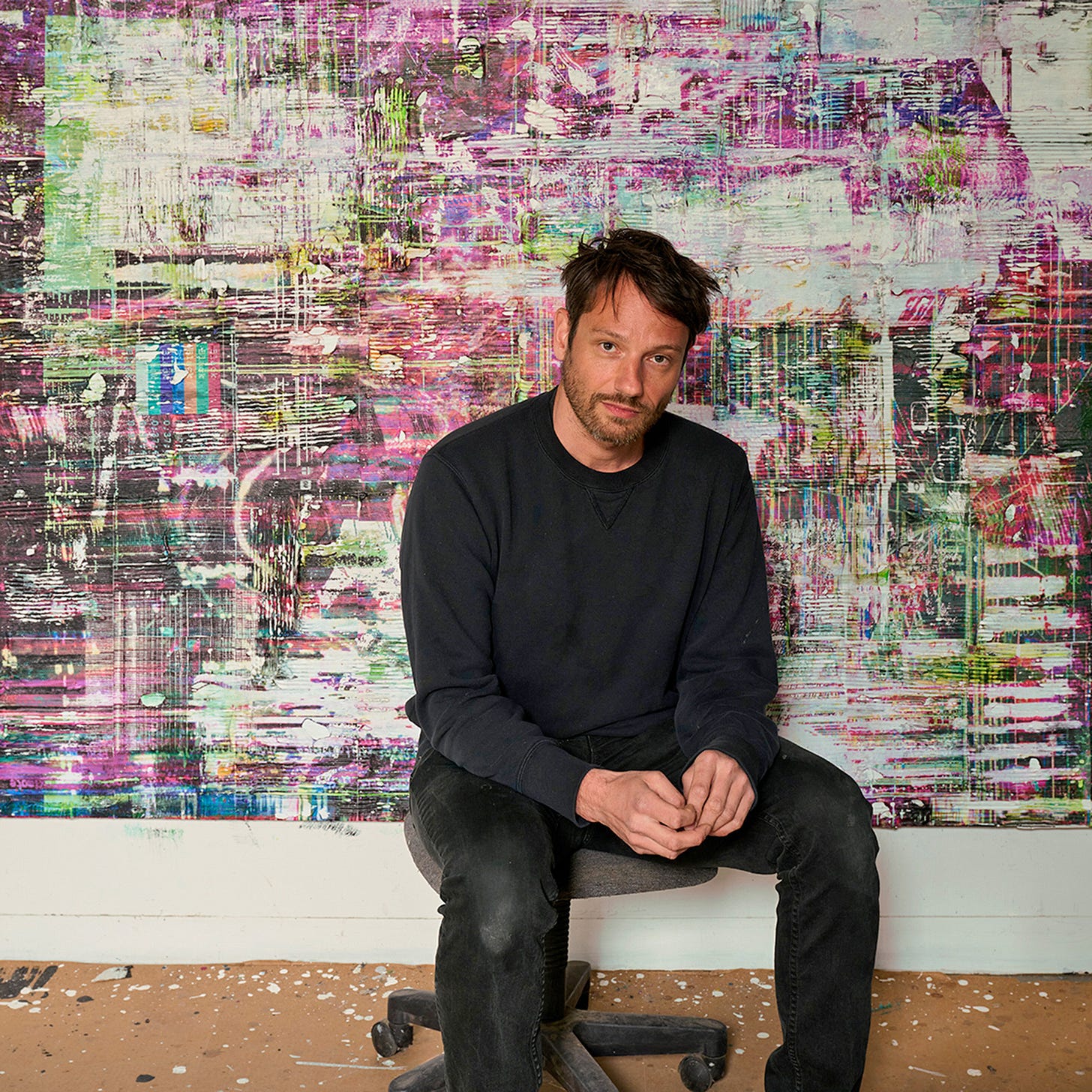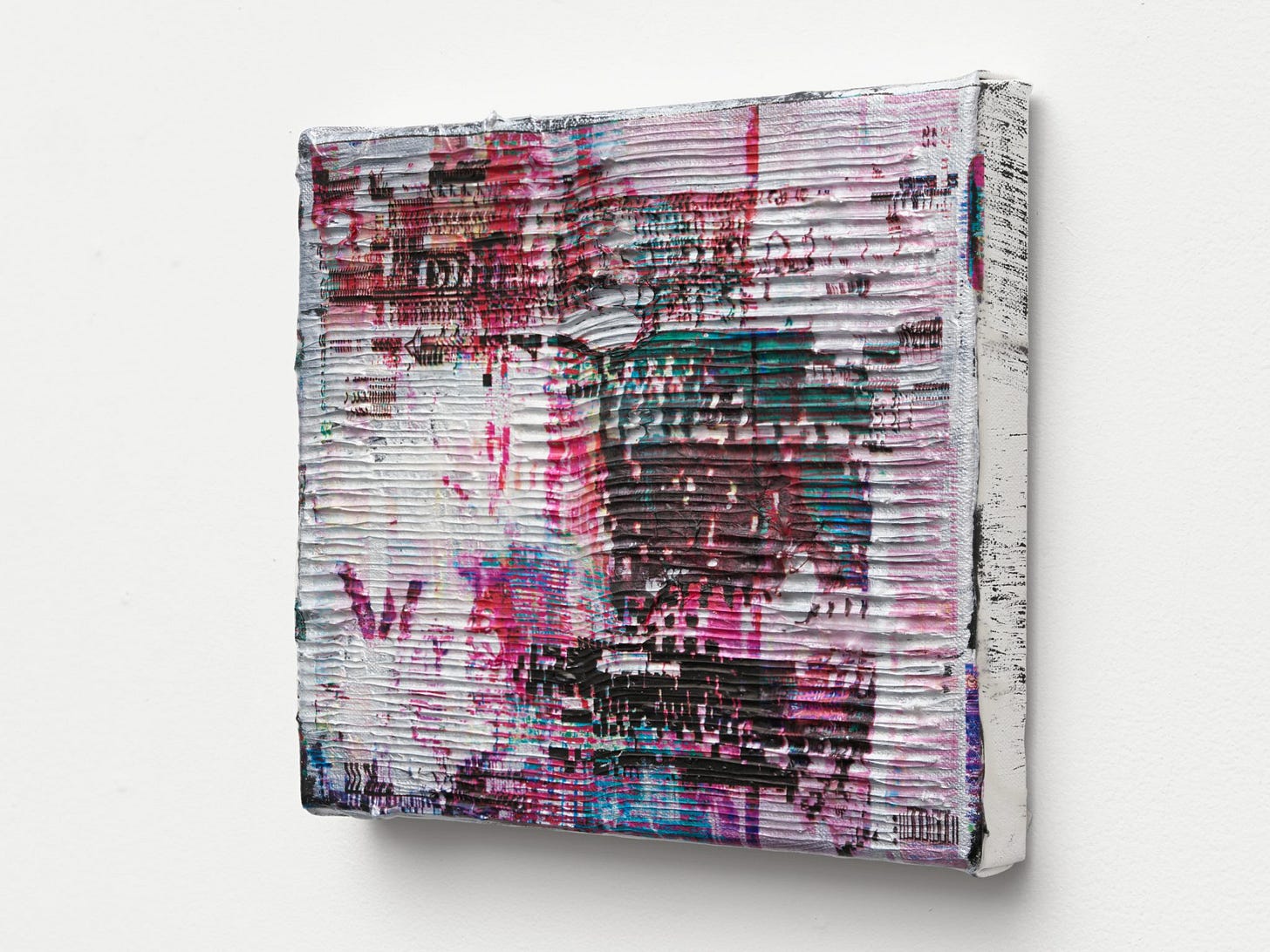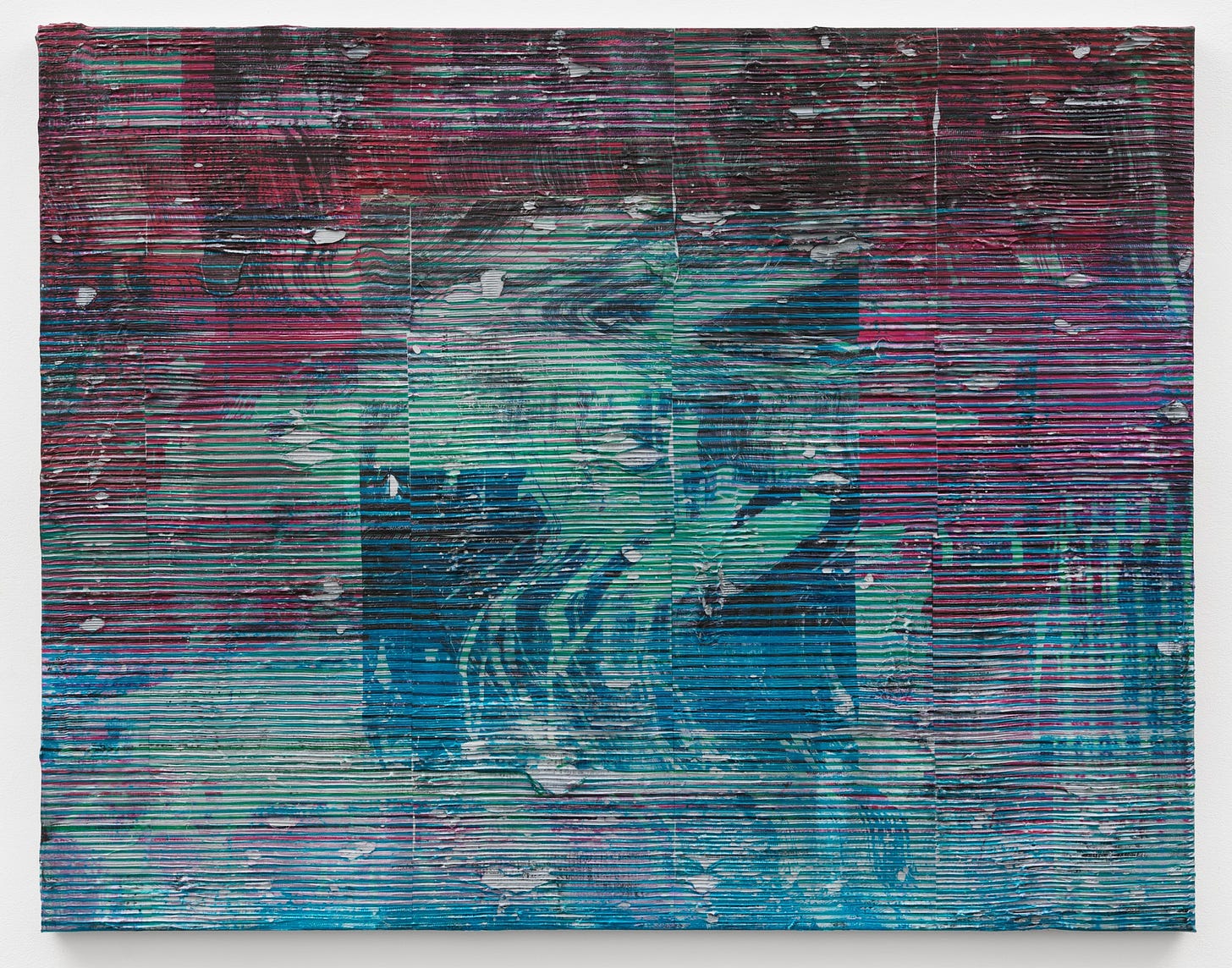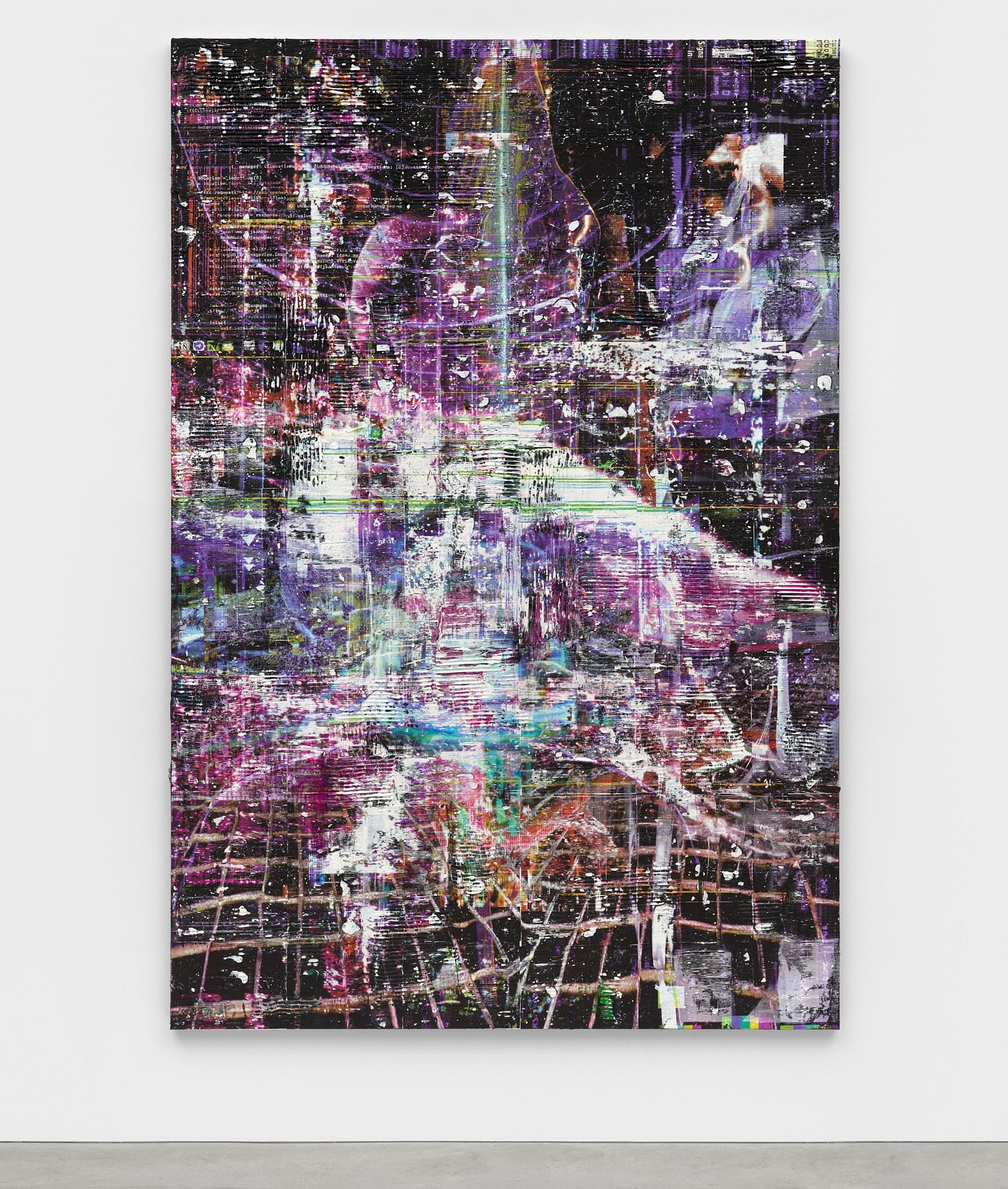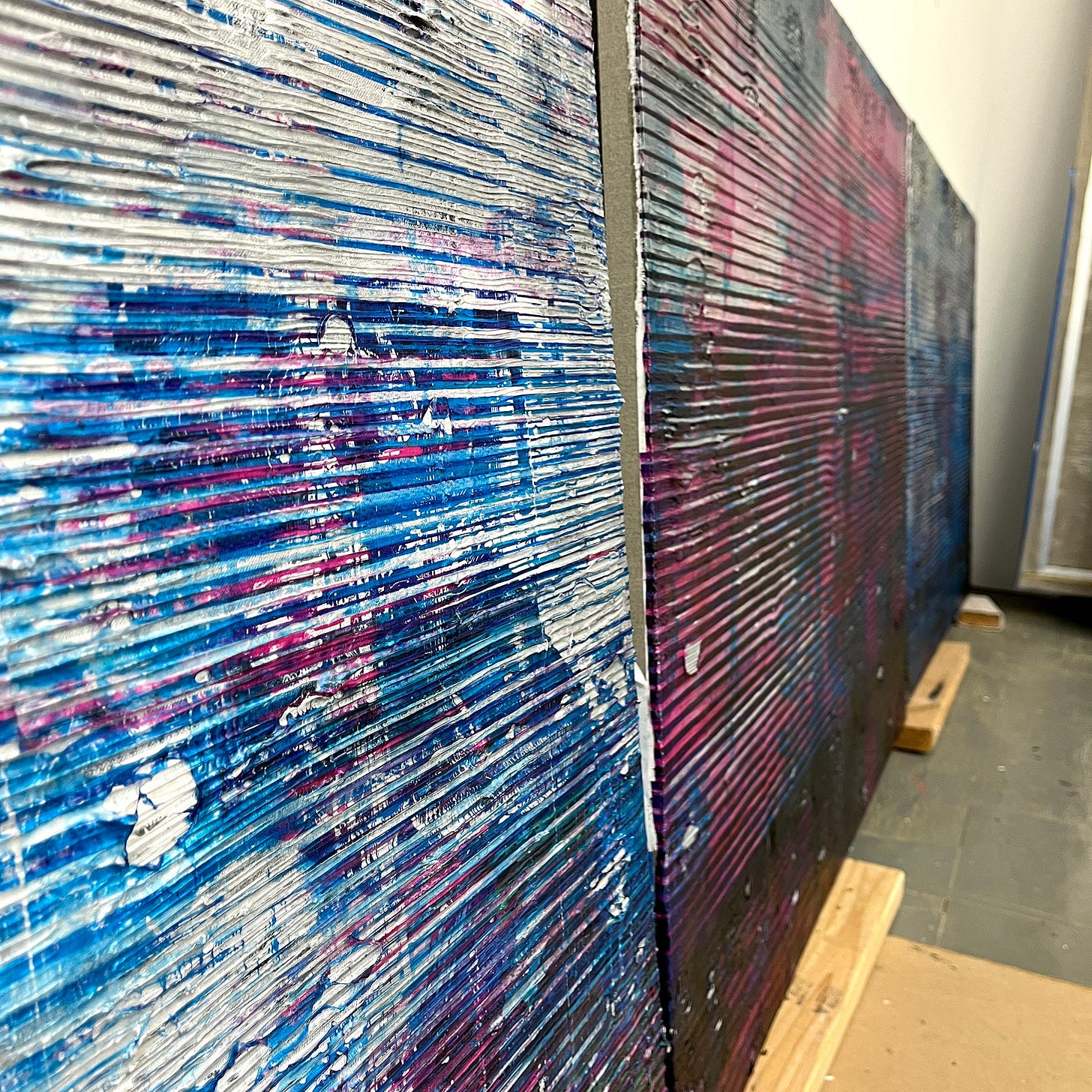The first time I saw Chris Dorland’s work in person was last year at Nicoletti Gallery in east London. His painting was beautifully glitchy and ambiguous, like a fuzzy VCR monitor flashing cool blues and purples, all broken horizontal lines and stuttering paint marks.
In photos, I had been attracted to the decayed geometry of Chris’s marks and the moody colours that dominated the works. In person, I was amazed to see how textured and handmade his paintings felt. There’s a wonderful convergence between technology and human touch in his work, with the paintings highlighting the potential of what happens when technology fails, when it shimmers and struggles to do the thing it was created to do. I think Chris’s work speaks to the beautiful effects of those technological errors, while exploring the tension between a cold digital realm and the handmade quality of his own creative practice.
Chris’s work also reminds me of the importance of seeing paintings in person to experience the amazing aura of the artwork. So if you’re in London, I definitely recommend catching his new works at his solo show with Nicoletti, which opens this evening and runs till 24 May. I was lucky enough to speak to Chris, who lives and works in NYC, on the eve of the show. I hoped to get a feel for the ideas and processes that get him excited as an artist.
Hey Chris. Looking at your work, there’s clearly a technological influence - the shimmering distortions and glitches. Do you use technology to make them or is it analog from start to finish?
My process toggles back and forth between analogue and digital states. I’m fascinated by how our eyes are increasingly unable to differentiate between handmade marks and those produced by machines.
Can you share any secrets regarding how you make them, or is the mystery important in maintaining the aura of the work?
I like to think of painting as a kind of alchemical magic. The process part of the work isn’t something I much enjoy getting into publicly, to be honest. I prefer to keep that part to myself. Looking and studying are the only meaningful ways to really figure out the structure of a painting. That’s what painters have been doing for hundreds of years. I try to encourage that as much as possible. My goal is to make an object as beguiling as possible so as to warrant the interest!
I wanted to get into the idea of the glitch, and the idea of technology producing these beautiful effects sort of by accident. How do you think your work speaks to that?
Different painters have different temperaments when it comes to exactitude and error. In my case, I learnt early that I’m happiest with relatively large margins for error and accident. So the glitch is both appealing conceptually, as much as it is visually.
For me, beauty in error represents a kind of hope. As our lives become increasingly algorithm and AI dominated, we are going to need glitches and cracks in the matrices more than ever.
Also, are there specific influences in regard to technology? The work makes me think of an old monitor with cathode ray tubes that I had, which had a wonderful fuzzy glow when I stuck a VHS in.
I love that description. There is something very painterly and atmospheric about early video technology. How technologies decay and fail is a big source of inspiration.
There was something oddly futuristic about VHS tapes and VCRs despite their clunky analogousness. The paradox of the “aesthetics of the future” is something I understood instinctively at a young age. I grew up at the dawn of the VHS era. Movies played a really big part of my childhood. I think that exposure had a powerful visual effect on me. There is also something enticingly sleazy about the glitch and tracking of old VHS tapes that I’ve always really loved. Like watching scrambled porn.
Do you ever feel there are limitations with paint and brushes and what you can do with them?
Yes. It’s the strength and curse of painting.
It seems like you’re someone who’s really pushed painting into a fresh area. Seeing your works in person, I was shocked by their thick texture.
Thanks! I’ve been trying to merge painting and digital technology for as long as I’ve wanted to be an artist. I’m really excited about the recent work; it accomplishes that fusion successfully while also staying true to the most important tenet of painting: being an interesting physical object for the body to interact with. Someone recently described my paintings as if they looked like they were dragged out of the digital and forced into our physical space. I really liked that.
I was curious if you were interested in the wider world of glitch, whether you were interested in glitch/ambient music too? I ask because I felt a kind of musical resonance in the work.
I grew up with electro and EDM. Those sounds played a big part in framing my aesthetic as a teenager in the 1990s, with electro and raves, along with sci-fi movies and their soundtracks.
Futurism also had an important role in my development when I just started to discover painting. Interestingly, the origins of the glitch aesthetic can be traced to the early 20th century with Luigi Russolo's Futurist manifesto L'arte dei rumori (The Art of Noises). When I first saw a Gerhard Richter abstract painting at 17 or whatever, I instinctively understood that work as glitch.
Synth is still my favourite sound. I recently discovered the Japanese composer Hitoshi Yoshimura. He worked in the 80s and 90s. It's amazing stuff.
Lastly, we’re speaking on the eve of your new show at Nicoletti Gallery in London. What can you say about your new works?
The Nicoletti exhibition is called Clone Repo (server ruin). The show consists of a new body work I’ve been referring to as Interface paintings alongside a large screen based video installation. The paintings read like distorted drone surveillance with the screens set on energy saving mode.
Follow Chris on Instagram: @chris_dorland
The Best Painting Shows in London This Month
Chris Dorland at Nicoletti (ends 24 May)
Rose Wylie at David Zwirner (ends 23 May)
James Cabaniuk at Workplace (ends 3 May)
Oliver Lee Jackson at Lisson (ends 17 May)
Kentaro Okumara at Vardaxoglou Gallery (ends 17 May)
Thanks for reading, see you next time!
Oliver & Kezia xx
Palette Talk is free and we hope to grow with your support. If you’ve enjoyed reading, drop us a donation via PayPal…




